
Alexios III Angelos, Latinized as Alexius III Angelus, was Byzantine Emperor from March 1195 to 17/18 July 1203. He reigned under the name Alexios Komnenos associating himself with the Komnenos dynasty.
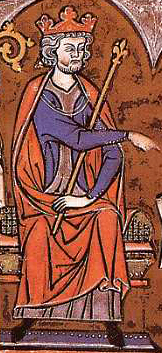
James I the Conqueror was King of Aragon, Count of Barcelona, and Lord of Montpellier from 1213 to 1276; King of Majorca from 1231 to 1276; and King of Valencia from 1238 to 1276. His long reign of 62 years is not only the longest of any Iberian monarch, but one of the longest monarchical reigns in history, ahead of Hirohito but remaining behind Queen Elizabeth II, Queen Victoria, and Ferdinand III of Naples and Sicily.

Alfonso II, called the Chaste or the Troubadour, was the King of Aragon and, as Alfons I, the Count of Barcelona from 1164 until his death. The eldest son of Count Ramon Berenguer IV of Barcelona and Queen Petronilla of Aragon, he was the first King of Aragon who was also Count of Barcelona. He was also Count of Provence, which he secured from Douce II and her would-be father-in-law Raymond V, Count of Toulouse, from 1166 until 1173, when he ceded it to his brother, Ramon Berenguer III. His reign has been characterised by nationalistic and nostalgic Catalan historians as l'engrandiment occitànic or "the Pyrenean unity": a great scheme to unite various lands on both sides of the Pyrenees under the rule of the House of Barcelona.

James II, called the Just, was the King of Aragon and Valencia and Count of Barcelona from 1291 to 1327. He was also the King of Sicily from 1285 to 1295 and the King of Majorca from 1291 to 1298. From 1297 he was nominally the King of Sardinia and Corsica, but he only acquired the island of Sardinia by conquest in 1324. His full title for the last three decades of his reign was "James, by the grace of God, king of Aragon, Valencia, Sardinia and Corsica, and count of Barcelona".

Eudokia Makrembolitissa was a Byzantine empress by her successive marriages to Constantine X Doukas and Romanos IV Diogenes. She acted as regent of her minor son, Michael VII in 1067, and resigned her regency by marriage to Romanos IV Diogenes. When he was deposed in 1071 she resumed the regency for her sons, but was soon forced to resign again.
Eudoxia, Eudokia or Evdokia is a feminine given name, which originally meant "good fame or judgement" or "she whose fame or judgement is good" in Greek. The Slavic forms of the name are East Slavic: Evdokiya, Yevdokiya ; South Slavic: Evdokija (Евдокија), Jevdokija (Јевдокија). It was mainly popular in late antiquity and during the Middle Ages, particularly in Eastern Europe. It continues to be in use today, usually in honor of various saints.
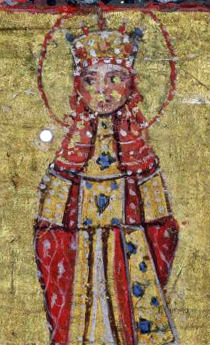
Agnes of France, renamed Anna, was Byzantine empress by marriage to Alexios II and Andronikos I Komnenos. She was a daughter of Louis VII of France and Adèle of Champagne.
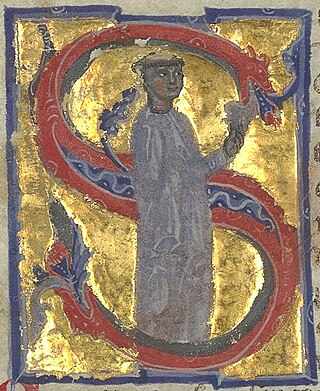
Arnaut de Mareuil was a troubadour, composing lyric poetry in the Occitan language. Twenty-five, perhaps twenty-nine, of his songs, all cansos, survive, six with music. According to Hermann Oelsner's contribution to the 1911 Encyclopædia Britannica, Arnaut de Mareuil surpassed his more famous contemporary Arnaut Daniel in "elegant simplicity of form and delicacy of sentiment". This runs against the consensus of both past and modern scholars: Dante, Petrarch, Pound and Eliot, who were familiar with both authors and consistently proclaim Daniel's supremacy.

Euphrosyne Doukaina Kamaterina or better Kamatera was a Byzantine Empress by marriage to the Byzantine Emperor Alexios III Angelos.
AlexiosBranas or Vranas was a Byzantine nobleman, attempted usurper, and the last Byzantine military leader of the 12th century to gain a notable success against a foreign enemy.
Eudokia Komnene was a relative of Byzantine Emperor Manuel I Komnenos, and wife of William VIII of Montpellier.

Marie of Montpellier was Lady of Montpellier and by her three marriages Viscountess of Marseille, Countess of Comminges and Queen of Aragon.
Isaac Komnenos or Comnenus, was the third son of Byzantine Emperor John II Komnenos by Irene of Hungary. He was bypassed by his father in favour of his younger brother Manuel I Komnenos for the succession, leading to a tense relationship between the two brothers after. He participated in the campaigns of his father and brother in Asia Minor, and was a fervent adherent of Patriarch Cosmas II of Constantinople, but little else is known about his life.
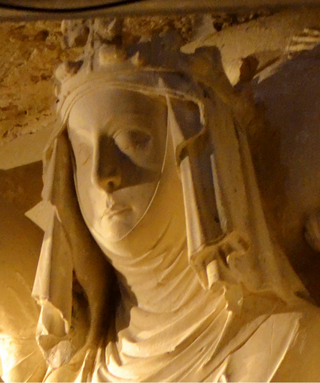
Blanche of Anjou was Queen of Aragon as the second spouse of King James II of Aragon. She was a member of the Capetian House of Anjou, she is also known as Blanche of Naples. She served as Regent or "Queen-Lieutenant" of Aragon during the absence of her spouse in 1310.

Peire Raimon de Tolosa was a troubadour from the merchant class of Toulouse. He is variously referred to as lo Viellz and lo Gros, though these are thought by some to refer to two different persons. On the other hand, lo Viellz could refer to his being of an early generation of troubadours. Eighteen of Peire Ramon's poems survive, one canso with a melody.
Constance of Aragon was Queen of Majorca as the wife of King James III. She was the eldest daughter of Alfonso IV of Aragon and his first wife, Teresa d'Entença.
William IX was the lord of Montpellier from 1202 until 1204. He was the last lord of the Guilhem lineage.

Alexios Komnenos was a Byzantine aristocrat and courtier. A son of Andronikos Komnenos and nephew of Emperor Manuel I Komnenos, he rose to the high rank of prōtostratōr in 1167. In 1176 he participated in the Myriokephalon campaign where, following the death of his older brother John, he was raised to the titles of prōtosebastos and prōtovestiarios. Following Manuel's death in 1180, he won the favour, and reportedly became the lover, of Empress-dowager Maria of Antioch. Through her he ruled the Byzantine Empire for two years as de facto regent of the underage emperor Alexios II Komnenos. The aristocracy challenged his dominance, led by the princess Maria Komnene, who plotted to assassinate the prōtosebastos. The plot was discovered and most conspirators arrested, but Maria and her husband fled to the Hagia Sophia, protected by Patriarch Theodosios Borradiotes and the common people of Constantinople.
Eudokia Komnene or Eudocia Comnena can refer to:
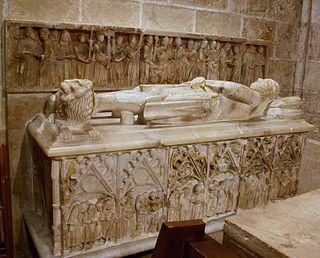
Bernat Guillem de Montpeller also known as Bernat Guillem I d'Entença was a noble, who married into the Catalan House of Entença. He was the lord of Fraga. He is best known for his participation in the Conquest of Majorca and Valencia during the Reconquista. He died after the Battle of the Puig in 1238.













